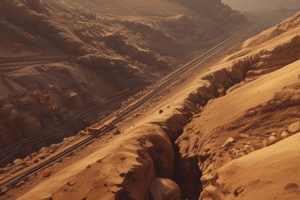Podcast
Questions and Answers
Which of the following best describes soil in engineering?
Which of the following best describes soil in engineering?
Who introduced the concept of the angle of repose?
Who introduced the concept of the angle of repose?
What is the main focus of geotechnical engineering?
What is the main focus of geotechnical engineering?
Which soil structure is typical of freshwater cohesive soils?
Which soil structure is typical of freshwater cohesive soils?
Signup and view all the answers
In the Atterberg Limits, which test determines the moisture content at which soil transitions from a liquid to a plastic state?
In the Atterberg Limits, which test determines the moisture content at which soil transitions from a liquid to a plastic state?
Signup and view all the answers
Which of the following particles is the largest in size?
Which of the following particles is the largest in size?
Signup and view all the answers
What is the primary disadvantage of the Standard Penetration Test (SPT)?
What is the primary disadvantage of the Standard Penetration Test (SPT)?
Signup and view all the answers
What is the purpose of the zero air void curve in soil compaction?
What is the purpose of the zero air void curve in soil compaction?
Signup and view all the answers
What is the plasticity index (PI) if the liquid limit (LL) is 45% and the plastic limit (PL) is 25%?
What is the plasticity index (PI) if the liquid limit (LL) is 45% and the plastic limit (PL) is 25%?
Signup and view all the answers
Which soil type is most susceptible to liquefaction?
Which soil type is most susceptible to liquefaction?
Signup and view all the answers
What is the primary advantage of the Cone Penetration Test (CPT)?
What is the primary advantage of the Cone Penetration Test (CPT)?
Signup and view all the answers
Which roller is best suited for compacting clayey soils?
Which roller is best suited for compacting clayey soils?
Signup and view all the answers
Calculate the degree of saturation (S) if the volume of water (Vw) is 6 cm³ and the total volume (V) is 20 cm³. Assume void volume (Vv) is 8 cm³.
Calculate the degree of saturation (S) if the volume of water (Vw) is 6 cm³ and the total volume (V) is 20 cm³. Assume void volume (Vv) is 8 cm³.
Signup and view all the answers
Which test is used to measure soil consistency in situ?
Which test is used to measure soil consistency in situ?
Signup and view all the answers
What is the minimum number of boreholes required for a structure with an area of 1200 m²?
What is the minimum number of boreholes required for a structure with an area of 1200 m²?
Signup and view all the answers
What is the effective size (D10) in soil gradation analysis primarily used for?
What is the effective size (D10) in soil gradation analysis primarily used for?
Signup and view all the answers
Study Notes
Soil Mechanics and Engineering Quiz - Part 1
- Soil Definition (Engineering): Uncemented aggregate of mineral grains and decayed organic matter.
- Angle of Repose: Introduced by Charles Augustin Coulomb.
- Geotechnical Engineering Focus: Application of soil and rock mechanics to construction.
- Typical Freshwater Cohesive Soil Structure: Flocculated.
- Atterberg Limits Plastic Limit Test: Determines moisture content where soil transitions from liquid to plastic.
- Largest Soil Particle: Gravel.
- Standard Penetration Test (SPT) Disadvantage: Provides only disturbed samples.
- Soil Classification System with Group Index (GI): AASHTO.
Soil Mechanics and Engineering Quiz - Part 2
- Zero Air Void Curve Purpose: Determines moisture content for maximum compaction.
- Soil Exploration Methods: Wash boring, trial pits, split-barrel sampling.
- Soil Gradation Curve Parameters: Percent finer vs. particle size.
- Void Ratio Calculation: Void ratio =(V/Vs), where V = total void volume and Vs = volume of solids.
- Plasticity Index (PI) Calculation: PI = LL - PL.
- Liquefaction Susceptible Soil: Saturated, loosely packed sands.
- Cone Penetration Test (CPT) Advantage: Continuous soil profiling.
- Clay Soil Compaction Roller: Sheepsfoot roller.
- Degree of Saturation (S) Calculation: S = (Vw/V) * 100.
- Soil Consistency In Situ Test: Vane Shear Test.
- Minimum Number of Boreholes for 1200m2 Structure: 3.
- Effective Size (D10) Purpose: Determining particle shape.
Soil Mechanics and Engineering - Miscellaneous
- True/False Statements: Specific statements about soil properties, testing methods, and classifications are presented as true or false. (Accuracy is important here, but you will need answers.)
Studying That Suits You
Use AI to generate personalized quizzes and flashcards to suit your learning preferences.
Related Documents
Description
Test your knowledge on soil mechanics and geotechnical engineering with this comprehensive quiz. Covering fundamental concepts like the angle of repose, Atterberg limits, and soil exploration methods, this quiz is perfect for students and professionals alike. Challenge yourself and enhance your understanding of soil properties and their applications in engineering.





